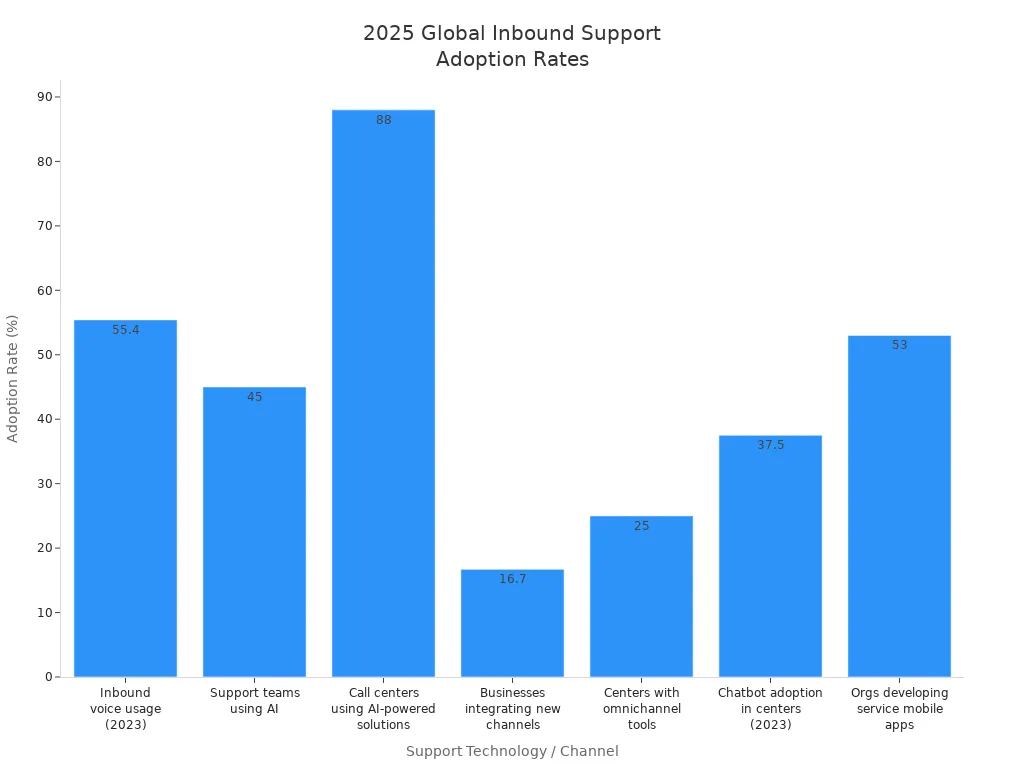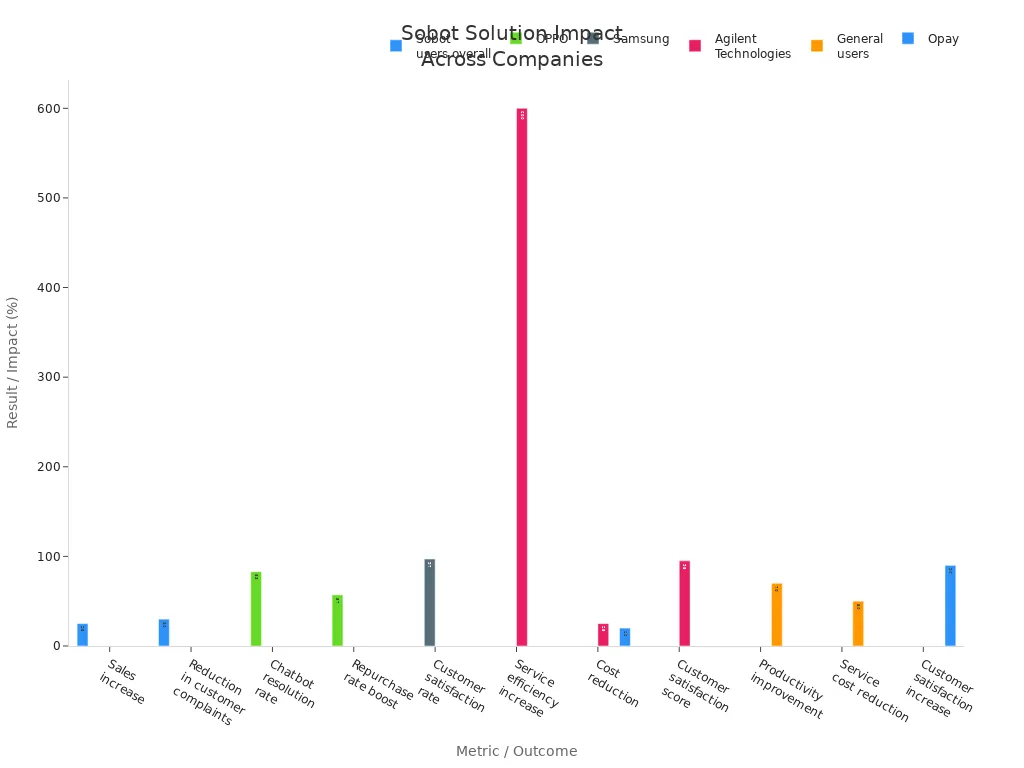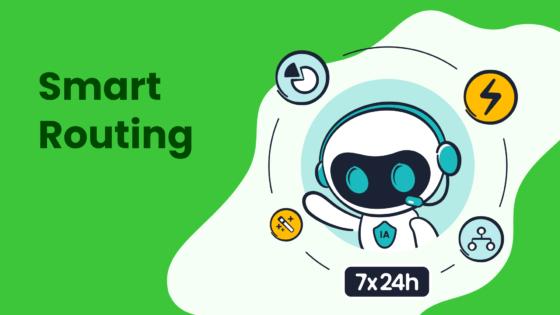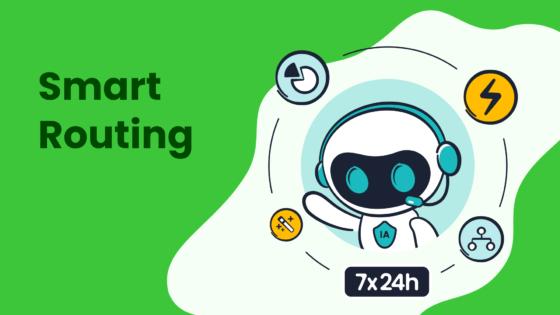Inbound Customer Support Explained for 2025

Inbound customer support enables you to connect with businesses whenever you need assistance, through channels such as phone, chat, or social media. Today, many global companies rely on advanced tools and Sobot AI to enhance customer service and accelerate support response times. The table below illustrates how technology is transforming inbound customer support.
| Metric | Adoption Rate / Statistic | Description |
|---|---|---|
| Inbound voice usage | 55.4% | Most used channel in contact centers |
| Call centers using AI-powered solutions | 88% | AI improves customer experience |
| Omnichannel routing tool adoption | 25% | Enables seamless engagement across channels |
| Chatbot adoption in contact centers | 37.5% | Growing use of automation |

Sobot call center solutions stand out as a leader in intelligent contact center technology, offering powerful AI-driven platforms that help you deliver fast, reliable inbound customer support.
Inbound Customer Support
Definition
Inbound customer support means you help customers when they reach out to your business. You answer their questions, solve their problems, and guide them through your products or services. Inbound customer support plays a key role in customer service because it builds trust and loyalty. When customers contact you, they expect quick and helpful answers.
You can see the formal definition and main functions of an inbound call center in the table below:
| Aspect | Description |
|---|---|
| Formal Definition | Inbound customer support refers to any communication initiated by the customer towards the business, including calls, emails, social media inquiries, and other channels. It is characterized by the customer starting the contact, usually to resolve a problem or ask a question. |
| Key Functions of Inbound Call Centers | 1. Helpdesk services: troubleshooting minor issues and providing guidance. 2. Product or technical support: handling more complex technical problems. 3. Payment and order processing: taking orders and processing payments over the phone. 4. Upgrades and renewals: assisting customers with subscription renewals and product upgrades. |
You will find inbound contact centers in almost every industry. For example, SaaS companies use inbound call centers to solve software issues. Retailers use them to answer product questions. Financial services use them to help with account problems. Each inbound contact center focuses on making sure customers feel heard and valued.
Sobot stands out as a leader in this field. Sobot’s inbound contact center solutions help you manage customer requests across many channels. Sobot uses AI and automation to make sure your customers get fast, accurate answers. Companies like OPPO and Samsung have seen higher customer satisfaction and faster response times after using Sobot’s inbound call center solutions.
How It Works
An inbound contact center uses technology and trained agents to handle customer requests. The process starts when a customer contacts your business. The system identifies the customer and pulls up their history. This helps agents understand the customer’s needs right away.
Here is how a modern inbound contact center works:
- The customer reaches out by phone, chat, email, or social media.
- The system checks the customer’s information and past interactions.
- Intelligent routing sends the request to the best agent or offers self-service options.
- Agents use real-time tools and data to solve the problem.
- The system tracks the outcome and collects feedback for future improvements.
Tip: Using an omnichannel platform like Sobot lets you manage all customer interactions in one place. This saves time and reduces errors.
Modern inbound call centers use features like IVR (Interactive Voice Response) to guide customers to the right department. AI-powered chatbots answer simple questions and free up agents for more complex customer issues. Real-time analytics help you see how well your team is doing and where you can improve.
Sobot’s inbound contact center platform brings all these tools together. You get smart call routing, AI chatbots, and a unified workspace. Sobot’s system supports over 50 languages and integrates with popular apps like WhatsApp and Salesforce. This makes it easy for your team to help customers from anywhere in the world.
You can see the impact of Sobot’s inbound call center solutions in the chart below. Companies using Sobot have seen higher sales, better customer satisfaction, and lower costs.

Key Channels
Inbound contact centers use many channels to connect with customers. Each channel has its own strengths. You can choose the best one for your business and your customers’ needs.
- Phone (Voice): The most common channel for urgent or complex problems. Customers like to talk to a real person when they need help fast. Sobot’s inbound call center offers global phone support with smart routing and call recording.
- Live Chat: Many customers prefer chat for quick questions. Sobot’s AI-powered chatbots handle simple requests and pass harder questions to human agents.
- Email: Good for detailed or non-urgent issues. Automated replies let customers know you received their message. Sobot’s unified workspace helps agents manage emails alongside other channels.
- Social Media: Customers often reach out on platforms like Facebook, Twitter, or WhatsApp. Sobot’s omnichannel solution lets you reply to social media messages in the same workspace as calls and chats.
- SMS/Text Messaging: Useful for reminders, updates, or short answers. Sobot supports SMS so you can keep customers informed.
Note: Customers expect you to respond quickly, no matter which channel they use. An inbound contact center with omnichannel support helps you meet these expectations.
Sobot’s inbound contact center solutions help you manage all these channels in one place. You can switch between phone, chat, email, and social media without losing track of the conversation. This makes your customer service faster and more personal.
Many companies have seen great results with Sobot. OPPO improved its chatbot resolution rate to 83% and increased its repurchase rate by 57%. Samsung reached a 97% customer satisfaction rate. Agilent Technologies improved service efficiency by six times and cut costs by 25%. These results show how a strong inbound call center can help you solve customer issues, boost loyalty, and grow your business.
Inbound vs. Outbound Contact Center
Differences
You will find clear differences between an inbound contact center and an outbound contact center. The main difference is who starts the conversation. In an inbound contact center, customers reach out to you for help, questions, or service. In an outbound contact center, your team contacts customers first, often for sales or surveys.
Here is a table to help you see the main differences:
| Aspect | Inbound Contact Centers | Outbound Contact Centers |
|---|---|---|
| Initiated By | Customers | Business |
| Primary Focus | Handle incoming customer communications for service and problem resolution | Proactively reach out for sales, lead generation, and research |
| Agent Skills & Training | Empathy, problem-solving, customer service | Sales skills, persuasive communication, resilience |
| Technology Used | IVR, CRM, AI chatbots | Predictive dialers, lead management, analytics |
| Performance Metrics | Resolution time, customer satisfaction, first call resolution | Lead generation, sales conversion, campaign effectiveness |
Sobot’s Voice/Call Center gives you the flexibility to manage both inbound and outbound call center operations. You can use smart IVR, AI-powered voicebots, and unified workspaces to handle all types of customer interactions.
Use Cases
You will see inbound contact centers in many industries. For example:
- In retail, an inbound call center helps customers with complaints, order processing, and product questions.
- In transportation, an inbound contact center manages reservations and ticket bookings.
- In food services, an inbound call center takes orders and collects feedback from customers.
Outbound contact centers focus on different goals. Your team might call customers to promote new products, conduct surveys, or follow up on leads. Sobot’s Voice/Call Center supports both types, so you can switch between inbound and outbound tasks as your business needs change.
Pros and Cons
Each type of contact center has its own strengths and challenges. Here is a quick comparison:
| Aspect | Inbound Contact Centers | Outbound Contact Centers |
|---|---|---|
| Main Focus | Customer service, handling incoming queries | Sales, lead generation, market research |
| Advantages | Personal touch, improved customer experience, can increase sales by answering questions | Boosts sales, full cost control, wide sales reach |
| Disadvantages | Less control over agent quality, possible knowledge gaps, cultural barriers | Limited product knowledge, divided attention, less direct control |
You can use Sobot’s Voice/Call Center to get the best of both worlds. The platform helps you manage high volumes of inbound call center requests and also supports outbound campaigns. This way, you can keep customers happy and grow your business at the same time.
Inbound Call Center Services

Core Functions
Inbound call center services help you deliver excellent customer experiences. You use these services to answer questions, solve problems, and guide customers through your products. When you set up an inbound contact center, you give your customers a direct way to reach your business for help.
Here are the main functions you find in an inbound call center:
| Core Function | Description |
|---|---|
| Customer Support | Resolves product/service inquiries and complaints to enhance customer satisfaction. |
| Technical Support | Provides specialized help for complex technical issues related to software and hardware. |
| Order Processing | Assists with order placement, tracking, and payment inquiries ensuring efficient fulfillment. |
| Billing and Payments | Handles billing questions, payment processing, refunds, and dispute resolution. |
| Appointment Scheduling | Manages scheduling, reminders, and cancellations, especially in healthcare. |
| Help Desk Support | Addresses a wide range of customer inquiries, complaints, and problem reporting. |
| CRM Integration | Allows agents to access customer history and preferences for personalized service. |
| Live Chat Support | Provides real-time assistance via websites and mobile apps. |
| Email Support | Manages customer inquiries and issues through email with systematic documentation. |
| Social Media Support | Responds to customer interactions on social platforms to maintain positive engagement. |
| Multi-language Support | Offers support in multiple languages to cater to diverse customers. |
| Emergency Support | Provides 24/7 immediate assistance for urgent issues. |
| Call Routing | Directs calls to the most qualified agent based on skills and availability. |
| Call Recording | Records calls for performance monitoring and training. |
| Reporting and Analytics | Collects and analyzes data to improve service quality and operational decisions. |
| Self-Service Tools | Includes FAQs and chatbots to help customers find solutions independently, reducing call volume. |
You use inbound call center services to improve customer satisfaction. Quick and effective support builds trust and a positive brand image. Efficient routing and automation let you handle large call volumes. Automation and optimized workflows help you reduce costs and use resources better. Skilled agents can turn support calls into sales opportunities. Agents also recommend products, increasing transaction value. CRM tools and data help agents resolve calls faster. Excellent service keeps customers loyal and reduces churn. Resolving issues on the first call makes customers happy and lowers repeat contacts.
Inbound contact centers rely on well-trained agents and advanced technology. Automatic Call Distributors (ACD) route calls to the right agent. CRM systems give agents access to customer history and preferences. Workforce management and quality control tools help you keep agents motivated and performing well. These tools help you deliver great customer experiences and build loyalty.
Tip: You can use helpdesk services to address a wide range of customer inquiries. This makes your inbound contact center more flexible and responsive.
Technology Integration
Technology plays a big role in making inbound call centers more effective. You use AI and automation to improve speed, accuracy, and customer satisfaction. Modern inbound contact centers use smart tools to handle routine tasks and free up agents for complex issues.
Here are some ways technology helps your inbound contact center:
- AI enables 24/7 support and automated responses to FAQs. Customers get answers any time, even outside business hours.
- Smart call routing and IVR systems connect callers to the best agent. This reduces wait times and improves customer experience.
- Sentiment analysis and real-time insights alert supervisors to negative interactions. You can step in and solve problems before they get worse.
- AI supports omnichannel communication. You automate SMS, email, and calls, making it easy for customers to reach you on their favorite channel.
- Automation reduces costs by handling repetitive tasks like scheduling and order status checks.
- Chatbots and virtual agents answer routine questions 24/7. This lowers the support load for your team.
- Conversational AI and IVR use natural language processing to understand speech. Customers get faster solutions and spend less time waiting.
- Real-time analytics from AI systems help you plan resources and monitor performance. You see trends and make better decisions.
Intelligent IVR systems handle many calls at once. They save money by automating routine tasks and cutting call handling times. You use customer data to personalize interactions. AI-powered call routing sends calls to the right agent or department. Self-service options let customers complete basic tasks without agent help. AI queue management distributes calls based on volume, agent availability, and customer preferences. Sentiment analysis helps you understand customer emotions and personalize service.
Note: Technology integration in your inbound contact center helps you deliver faster, smarter, and more personal support. You can use helpdesk services, chatbots, and AI tools to make your team more efficient.

Sobot Voice/Call Center
Sobot’s Voice/Call Center gives you a powerful platform for inbound contact center operations. You use advanced AI to deliver human-like interactions and automate routine tasks. Sobot’s Voicebot uses real-time speech recognition, natural language processing, and large language model reasoning to understand customer needs. Text-to-speech technology makes conversations sound natural and friendly.
You can handle both inbound and outbound calls with Sobot. The system manages over 50% of customer interactions autonomously. When needed, it transfers calls to human agents. Sobot’s Five-AI system covers omnichannel AI, scenario-based AI for retail and e-commerce, multi-faceted AI for customers, agents, and administrators, generative AI powered by advanced language models, and secure AI for data privacy and compliance.
Sobot’s Voice/Call Center stands out because it supports voice, chat, email, and social media channels. You get a complete AI ecosystem with AI Agent, AI Copilot, and AI Insight. The platform has matured over 10 years, integrating the latest technologies for a robust and efficient customer experience.
Here are some key features you get with Sobot’s inbound call center:
- Intelligent IVR: Customize greetings, build menus, and route calls to agents or teams.
- Unified Workspace: Manage calls and customer information in one place.
- Real-time Monitoring and Analysis: Track call data and agent performance.
- Bulk Outbound Task: Automate outbound calls and assign leads based on priorities.
- Call Tracking: Analyze call data for better insights.
- Seamless Integration: Connect with CRM and other business systems.
- 99.99% SLA: Enjoy high system uptime and global network support.
- Global Number Availability: Access phone numbers worldwide.
- AI-powered Voicebot: Interact with customers using intelligent voice technology.
- Smart Call Routing: Automatically direct calls to the right agent.
- Time Zone Support: Collect and analyze data based on customer location.
Sobot’s inbound contact center helps you serve customers in retail, financial services, gaming, education, and more. You can see real results from companies like OPPO. OPPO used Sobot’s chatbot and ticketing system to handle high volumes of customer inquiries. The chatbot resolved 83% of issues, and OPPO saw a 94% positive feedback rate. Repurchase rates increased by 57%. Sobot helped OPPO optimize its knowledge base, reducing maintenance efforts by 90%. The integration of global channels and business systems improved data accessibility and customer satisfaction.
Other companies, such as Samsung, Agilent, and OPay, have also benefited from Sobot’s inbound call center solutions. OPay doubled its efficiency and improved customer experience by using Sobot’s multi-language, multichannel unified access and centralized processing system. Agilent improved service efficiency by six times and cut costs by 25%. These examples show how Sobot’s inbound contact center can help you achieve better results.
Callout: Sobot’s inbound call center services give you the tools to deliver fast, reliable, and personalized support. You can handle large volumes of customer inquiries, automate routine tasks, and improve customer satisfaction.
You can learn more about Sobot’s Voice/Call Center and see how it can transform your inbound contact center by visiting Sobot Voice/Call Center.
Benefits for Customer Service

Customer Experience
Inbound customer support shapes how customers feel about your business. When you provide fast, empathetic, and personalized support, you build trust and loyalty. You can turn a negative moment into a loyalty-building experience. Here are some ways inbound customer support improves customer experience and satisfaction:
- Customers get answers quickly, which increases satisfaction and reduces frustration.
- Personalized support makes customers feel valued.
- High first call resolution means customers do not need to call back, leading to a better customer experience.
- Positive support experiences increase repeat purchases and reduce churn.
- Satisfied customers are more likely to recommend your brand to others.
A Salesforce study found that 92% of customers are more likely to buy again after a positive support experience. Businesses that excel in customer service grow faster than others. Metrics like CSAT scores, resolution rates, and retention rates show how well your support team performs. When you focus on customer satisfaction, you create loyal customers who help your business grow.
Operational Efficiency
You can improve operational efficiency by using advanced inbound customer support solutions. Sobot helps you respond faster by using intelligent call routing and AI-powered chatbots. These tools handle routine questions, so your agents can focus on complex issues. Here are some ways technology boosts efficiency:
- AI-powered virtual agents answer FAQs and reset passwords, reducing call volumes.
- Voice-enabled IVR systems let customers use voice commands for quick self-service.
- Smart call routing connects customers to the right agent, improving first call resolution.
- Automated notifications reduce the number of incoming calls by answering common questions before customers ask.
Companies using Sobot have seen up to 90% faster response times and a 30% reduction in customer service costs. OPPO, for example, achieved an 83% chatbot resolution rate and a 94% positive feedback rate. These results show how technology can help you deliver better customer experience and satisfaction while saving time and money.
Brand Impact
Effective inbound customer support strengthens your brand and boosts your Net Promoter Score (NPS). When you solve problems quickly and provide a great service experience, customers become loyal promoters. Here is how strong support impacts your brand:
- You keep more customers by resolving issues that might cause them to leave.
- High NPS means your customers are happy and likely to refer your brand to others.
- Loyal customers share positive stories, helping your brand reputation grow.
Inbound support channels also collect feedback that helps you understand what drives satisfaction and loyalty. Sobot’s AI analyzes every interaction to find ways to improve. By focusing on customer satisfaction and first call resolution, you build a brand that customers trust and recommend.
Best Practices for Inbound Customer Support
Agent Training
You can build a strong inbound call center by investing in agent training. Start with real-world call transcripts that show different customer scenarios. Use these examples to help agents learn how to handle common and complex issues. Train agents to understand customer intent and emotions using natural language tools. Test their skills with live scenarios, including different accents and languages. Monthly training sessions on product updates and scenario-based exercises keep your team sharp. Combine AI and human agents for a hybrid model, letting AI handle routine tasks while humans solve sensitive problems. Continuous learning and feedback loops help agents improve accuracy and boost customer satisfaction.
Tip: Train agents on multilingual data and regional accents to make your inbound customer support more inclusive.
Technology and Automation
You can use technology and automation to make your inbound call center more efficient. AI-powered chatbots answer simple questions and guide customers through troubleshooting. Automated ticketing systems organize and route requests to the right agents, reducing wait times. Intelligent call routing connects customers to the best agent for their needs. Real-time coaching tools give agents instant access to knowledge articles and suggestions. Automation of repetitive tasks frees agents to focus on personalized support, improving customer experience and satisfaction.
| Technology Feature | Benefit |
|---|---|
| AI Chatbots | 24/7 support, faster response |
| Automated Ticketing | Organized workflow, reduced wait times |
| Sentiment Analysis | Proactive issue resolution |
| Real-Time Coaching | Improved agent performance |
Omnichannel Strategies
You can deliver seamless inbound customer support by using omnichannel strategies. Define clear goals and key performance indicators for your support channels. Focus on the channels your customers prefer, such as SMS, chat, or social media. Integrate your omnichannel platform with tools like CRM and ecommerce systems to centralize customer data. Sobot’s unified workspace lets agents see all customer interactions in one place, making support more personal and efficient. Train your team to handle conversations across channels and maintain a consistent brand voice. Use automation and AI to handle routine inquiries, freeing agents for complex issues.
Note: Start with two or three key channels and expand as your team gains experience.
Measuring Success
You can measure the success of your inbound call center by tracking important metrics. Monitor service level usage, average speed of answer, and first contact resolution. Use customer satisfaction scores and agent utilization rates to see how well your team performs. Track self-service success rates to find out how many issues customers solve on their own. Regularly review these metrics and use analytics to guide improvements. Sobot’s platform provides real-time data and reporting, helping you optimize your inbound customer support for better satisfaction and efficiency.
Inbound customer support drives business success in 2025. You see strong demand for automation, higher engagement rates, and improved conversion when you upgrade your approach. Sobot’s intelligent, omnichannel platform gives you 24/7 automated service, advanced analytics, and seamless interactions. To stay ahead, you should answer calls quickly, personalize every interaction, and use AI-powered tools. Train your team, measure performance, and refine your processes for lasting growth.
- Increased automation requests and ROI highlight the need for modern inbound support.
- AI-powered platforms like Sobot improve efficiency and customer satisfaction.
- Next steps: respond fast, personalize, leverage technology, and train your team.
FAQ
What is inbound customer support?
Inbound customer support means you help customers when they contact your business. You answer questions, solve problems, and guide them through your products or services. Inbound customer support builds trust and keeps customers happy.
Why does inbound customer support matter for my business?
Inbound customer support helps you keep customers satisfied. Quick and helpful support increases loyalty and encourages repeat business. You can also collect feedback to improve your products and services.
Which channels can I use for inbound customer support?
You can use phone, live chat, email, social media, and SMS for inbound customer support. Each channel gives your customers a way to reach you. Omnichannel solutions let you manage all these channels in one place.
How does technology improve inbound customer support?
Technology makes inbound customer support faster and smarter. AI chatbots answer simple questions. Smart routing sends customers to the right agent. Analytics help you track performance and find ways to improve your support.
How can I measure the success of my inbound customer support?
You can track metrics like response time, first call resolution, and customer satisfaction scores. These numbers show how well your inbound customer support works. Regular reviews help you find areas to improve.
See Also
Best Contact Center Technologies Evaluated For 2024
Discover Leading Cloud-Based Contact Centers In 2025
Comprehensive Guide To Omnichannel Call Center Platforms
Comparing The Best Voice Of Customer Software Solutions
Essential Guide To Quality Management Systems In Call Centers
